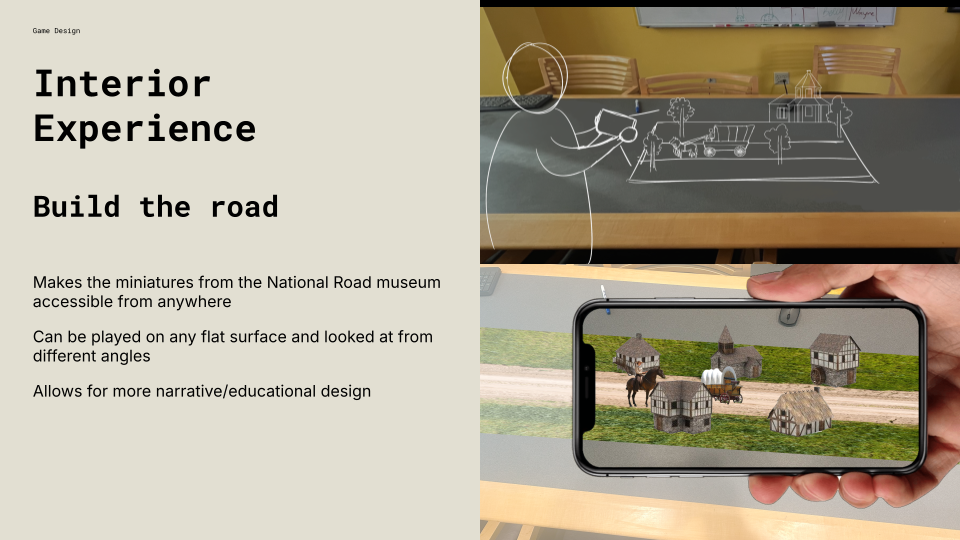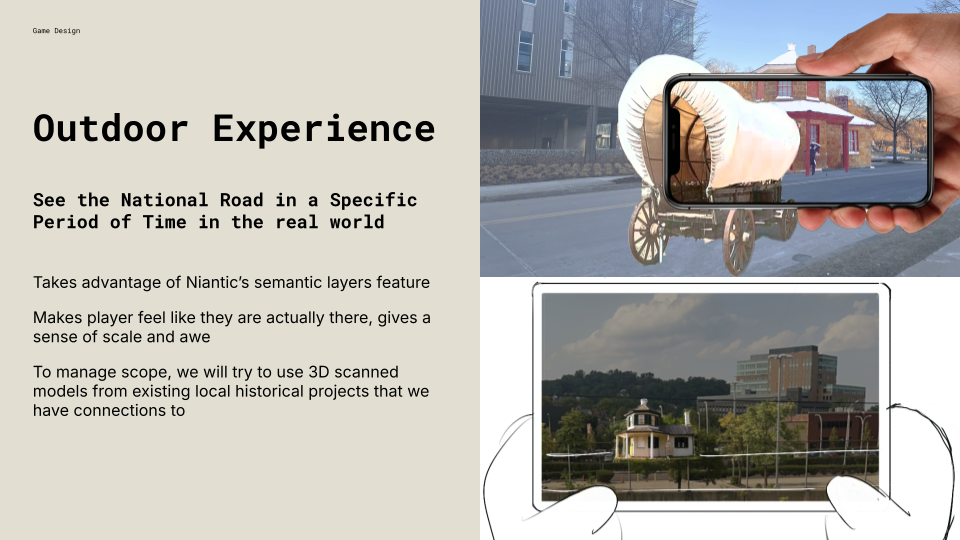Overview
- Quarters Walkaround
- Synthesizing Feedback
- Challenges
- Next Week’s Goals
Quarters Walkaround
In preparation for our Quarters Walkaround on Wednesday, we came up with two distinct directions that our project could go in, which we wanted to receive feedback on. One is an indoor tabletop experience, which is very flexible to be played almost anywhere, and allows us to imbue our product with significantly more narrative and educational design. The second is a fully outdoor experience, which takes advantage of the Niantic Spatial platform in a way that the first does not require, and which has the benefit of making the player feel more immersed in the environment, as if they are actually in the scene, and provides a sense of scale and awe.


Going into Quarters, one thing we were sure about was that we needed to manage scope and we didn’t want to do essentially 2 projects at once. In other words, we will need to pick one of the two directions to commit to. We should think about ways to simplify both versions, such as using pre-built, realistic 3D assets in the outdoor version. Another element to consider is the players’ motivation for caring about developing the road. One possible design decision is to make the player take on the role of a tollhouse keeper to become more invested.
For our experience and potentially transformational goals, we thought about how educators could use this app or game either before or after field trips to sites like the National Road Museum to get kids more interested or keep them interested in the National Road and related historical topics.
Synthesizing Feedback
After Quarters, we organized the feedback from each group into an affinity diagram to pull out the most common sentiments.

The questions and areas to focus on that we got from the experience can be summarized by 4 general categories:
- Scope: One location is definitely better than trying to do multiple, and we should aim for a vertical slice. Different faculty had different preferences and opinions on whether an indoor or outdoor experience would be more successful.
- Enjoyment/Value for the Audience: How will our experience be fun for teens in our target audience who have no prior familiarity with the National Road? What is fun and interesting in general about what we are designing?
- AR/Technology: What does AR give us that other platforms can’t achieve? How do we balance making something that shows off the tech with something that is actually fun for our audience?
- Location/Context: Is it actually beneficial for this experience to work from anywhere? Where should our audience play this? Should it be part of a bigger educational activity (like a road trip or visit to the National Road Museum)?
In our instructor meeting we discussed how to take this feedback and move forward, so that we could begin creating prototypes and playable builds as soon as possible.
We need to further explore the capabilities of AR technology, since this project was pitched to be an AR experience, so it’s a given that we will use AR and cannot change that component. The rationale for choosing AR was the opportunity to provide movement and interaction to old-school, static dioramas in the museum.
As for the location, our decision to make this experience playable anywhere makes sense because very few people know what the National Road is, and we want this to be a tool that can introduce them to it. If we made a tabletop experience, we would need to really land the gameplay and create something unique and innovative in order to have a successful project that meets our goals, as we would be cutting out a big piece of the pitch if we didn’t use Niantic’s semantic layer detection outside.
On the enjoyment and audience value side, having a narrative will be a lot more difficult and not work as well if we choose the direction of an outdoor experience, but we want to start with narrowing down our player experience goal and deciding what we want the player to feel. As inspiration, we looked at the Oregon Trail tabletop game, where a large aspect of that game is intentional frustration, and the game successfully achieves its emotional and experiential goals.
Ultimately, we decided to pursue an experience that is played outdoors, so that we continue to use the Niantic Spatial Platform, which was a big aspect of the original pitch, and that we could lean into the ways that life-scale immersive environments could be an interesting medium for an interactive experience.
Challenges
The biggest challenge for this week was committing to a design direction that we felt most aligned with our project and personal goals, balancing the possible risks and benefits of each version of our design, as well as which we felt we would learn the most from pursuing.
Next Week’s Goals
- Create several tech probes that show possible interactions and just rendering a scene in general. Start incorporating visuals from the artists and see what’s actually exciting in this space
- Follow up with Portals Project team to meet and get models for Searights Tollhouse and other buildings
- Make progress in anticipation for halves on the art, programming, and historical research sides
